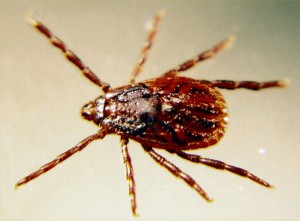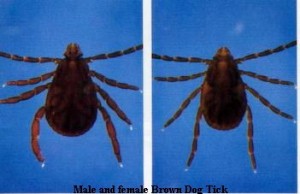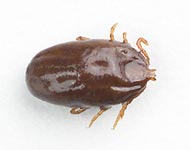
Brown Dog Tick
Brown Dog Tick (Rhipicephalus sanguineus)
The brown dog tick is probably the most widely distributed tick in the world and is found throughout US. A “clean” dog can be infested from a variety of sources, including other infested residences in the area, and poorly maintained boarding kennels. Ticks are not transferred from one dog to the other by direct contact. A feeding tick must first drop from the dog to molt before it reattaches to the same or another host for an additional bloodmeal. All growth stages can be found sucking blood almost anywhere on the dog when infestations are severe. If allowed to continue, this activity may result in loss of vitality by the pet and irritability. The tick can be a real nuisance if the infested dog lives in the home. These ticks will often emerge in great numbers from furniture, baseboards, moldings, electrical outlet boxes, curtains, etc. The brown dog tick has been reported to be a vector of Rocky Mountain spotted fever in the western hemisphere.
An engorged female is fertilized by a male while still on the dog. She falls off after mating and seeks a sheltered area in which to lay her 1,000-3,000 eggs. She can lay her eggs in any protected area, however, egg masses are likely to be found in above-ground crack and crevices (for example, kennel roofs) because of her behavioral tendency to crawl upward. The female dies soon after depositing eggs and depending on temperature and humidity, the eggs hatch in 19-60 days. The tiny light brown larvae (“seed tick”) have 6 legs and attach to a dog at the first opportunity. A larva can survive for 8 months without a bloodmeal. After larvae attach to a host they engorge themselves for 3-9 days, changing from a flattened to a globular shape, and light brown to bluish-gray color. They leave the host, seek a sheltered area, and molt in 6-23 days to become an 8-legged reddish-brown nymph. Nymphs can survive for extended periods without food or water.
Having found a host, the nymph will engorge a bloodmeal in 4-9 days, and become oval and dark gray. After leaving the host they hide and molt to an adult in 12-29 days (hard ticks have a single nymphal stage whereas soft ticks may have several). The adults seek a dog, engorge blood for 6-50 days (adults can survive for 18 months without food), mate, and drop off to lay eggs and repeat the life cycle. At 29ø C (85ø F) the life cycle can be completed in 63 days. Under normal environmental conditions and host availability, there may not be more than 4 generations per year.
The brown dog tick does not do well outdoors in most area of the US. They prefer warm, dry conditions where dogs live. After feeding and dropping off the host, they do not travel far. They attach anywhere on the dog and move upward. Adults attach on the ears or between toes. Larvae and nymphs attach on backs.
Management
Controlling the brown dog tick is difficult and may require the services of professional pest control operator. A 4-step process is involved in tick control: sanitation, treatment of dog/pet, indoor treatment, and outdoor treatment. Control of the brown dog tick requires extreme persistence by the pet owner. If the infestation is throughout the residence the dog, home, and yard will need to be chemically treated simultaneously. Incomplete treatments will prolong the infestation and result in an over use of pesticides. Insecticides to control this pest should have a reasonable residual efficacy. Products like Bayer Advanced Home Insect Control (cyfluthrin) or Othro’s Home Insect Defense (bifenthrin) are long-lasting and registered for use inside homes. Be sure to read and follow all instructions and safety precautions found on the label before using any pesticide.
The primary objective when applying a pesticide to control this pest is to concentrate on those areas which are frequented by the dog. Outdoor applications may include the crawl space beneath homes, kennels, favorite napping areas in the yard and/or garage, etc. Favorite areas indoors are carpets and upholstered furniture. If fabrics need to be sprayed, read the pesticide label first for possible staining precautions. If in doubt, spray a small and inconspicuous area, allow the pesticide to dry, and observe for staining. If upholstered furniture require treatment, remove the cushions and spray all crevices and seams. Attention should also be directed to carpet edges, baseboards, doorways, and floor/wall cracks and crevices. Treatment of outdoor and indoor areas may have to be repeated depending upon the severity of the infestation and pesticide label instructions. Do not treat if ticks are not observed on the pet or premises.
Treatment of the pet can be done by the owner or a veterinarian. A wide variety of commercial products are available for baths or dips.






 Print
Print Email
Email